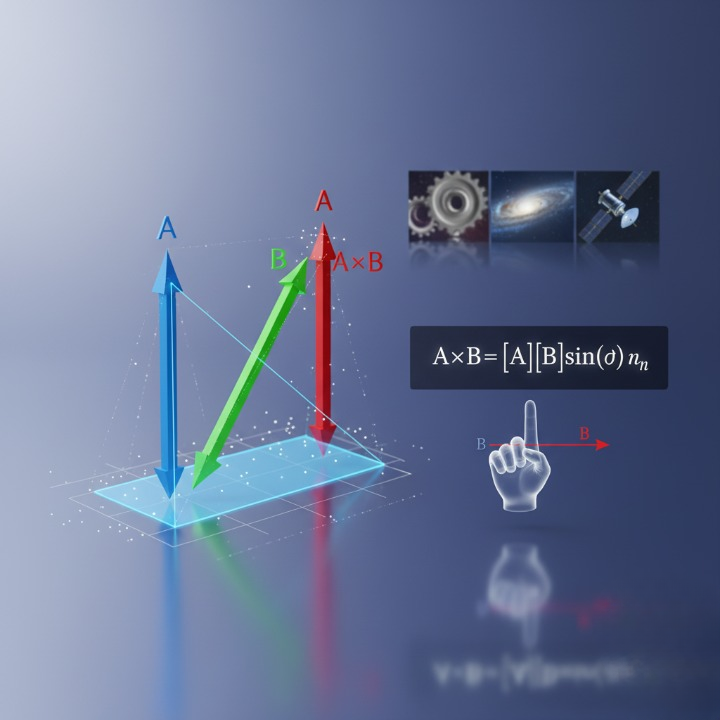🧭 Introduction: The Beauty of Vectors in Motion
In the world of geometry and physics, vectors are the silent language of direction and force. They describe how objects move, rotate, and interact in three-dimensional space. At the heart of these interactions lies a remarkable operation — the cross product formula. It’s more than a simple calculation; it’s a geometric tool that brings direction to magnitude and motion to mathematics.
Understanding the cross product means understanding how the world moves — from spinning planets to turning wheels.
📐 What Is the Cross Product Formula?
The cross product, often represented as A × B, is an operation performed on two vectors in 3D space. Unlike the dot product (which gives a scalar), the cross product produces another vector that is perpendicular to both A and B.
The formula is expressed as:
A×B=∣A∣∣B∣sin(θ) nA × B = |A||B| \sin(\theta) \, \mathbf{n}
Where:
-
∣A∣|A| and ∣B∣|B| are the magnitudes (lengths) of vectors A and B.
-
θ\theta is the angle between them.
-
n\mathbf{n} is a unit vector perpendicular to both A and B, determined by the right-hand rule.
In component form, if
A=(Ax,Ay,Az) and B=(Bx,By,Bz),A = (A_x, A_y, A_z) \text{ and } B = (B_x, B_y, B_z),
then
A×B=∣ijkAxAyAzBxByBz∣=(AyBz−AzBy)i−(AxBz−AzBx)j+(AxBy−AyBx)kA × B = \begin{vmatrix} \mathbf{i} & \mathbf{j} & \mathbf{k} \\ A_x & A_y & A_z \\ B_x & B_y & B_z \end{vmatrix} = (A_yB_z – A_zB_y)\mathbf{i} – (A_xB_z – A_zB_x)\mathbf{j} + (A_xB_y – A_yB_x)\mathbf{k}
This determinant form reveals how algebra and geometry intertwine — transforming numbers into spatial meaning.
⚙️ The Geometry Behind the Formula
What makes the cross product fascinating is its geometric interpretation.
-
The magnitude of A×BA × B represents the area of the parallelogram formed by A and B.
-
The direction of A×BA × B is perpendicular to the plane containing A and B.
This dual meaning — area and direction — turns the cross product into a cornerstone for describing rotation, torque, and angular momentum.
🧠 Why the Cross Product Matters
The cross product formula isn’t just academic—it’s everywhere in real life:
-
Physics: Used to calculate torque (τ=r×F\tau = r × F) and magnetic forces on moving charges.
-
Engineering: Helps analyze rotational motion, structural balance, and 3D modeling.
-
Computer Graphics: Determines surface normals for lighting and shading effects in 3D design.
-
Navigation: Used in determining orientation and stability for aircraft and spacecraft.
Every time something spins, rotates, or aligns itself in 3D space, the cross product quietly defines the rules.
🖐️ The Right-Hand Rule: Finding Direction
Direction is a vital part of the cross product. The right-hand rule provides an easy way to find it:
-
Point your index finger in the direction of vector A.
-
Point your middle finger in the direction of vector B.
-
Your thumb then points in the direction of A×BA × B.
This simple gesture encodes an elegant geometric truth — one that defines motion and orientation across disciplines.
🚀 Real-World Example
Imagine tightening a bolt with a wrench.
-
The force you apply is vector F.
-
The distance from the pivot is vector r.
The torque that turns the bolt is given by the cross product:
τ=r×F\tau = r × F
The greater the angle between r and F (up to 90°), the more torque you generate — proof that geometry is literally turning the world.
🎯 Conclusion: Geometry in Motion
The cross product formula is more than a mathematical operation—it’s a window into how movement, force, and direction coexist in space. From engines to galaxies, it governs how systems twist, turn, and align.
To master the cross product is to see geometry not as static shapes, but as motion frozen in formula — a bridge between math and the mechanics of the universe.







